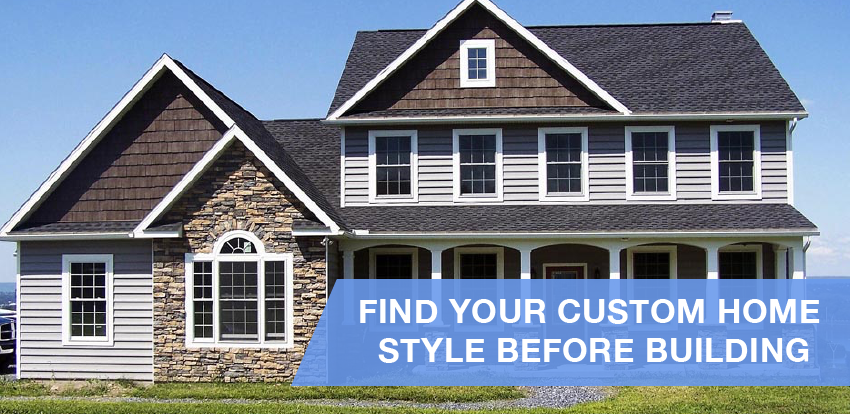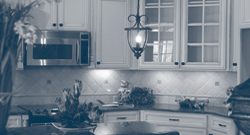Find Your Custom Home Style Before Building

You have decided to build a custom home. That means you get free reign of every decision, from the overall style and square footage down to the drawer pulls and other tiny details, and it is a dream come true. However, all those custom home design decisions you were once excited about can become overwhelming if you don’t have a clear style direction.
Choosing the overall style and design is one of the first decisions you need to make when building a custom home. With that decision out of the way, the other design elements start to fall into place. So how do you go about choosing that initial style and design? We have some tips to help you consider your personal preferences and other factors that go into the decision.
Why It’s Important to Have a Clear Vision of What You Want Before Building
Having a solid sense of the style of your home ahead of time is key to a successful custom-built home. Why does it matter? Can’t you make decisions as you go along?
While you might not need to have every single decision made before breaking ground, having a clear direction in terms of style, size and furnishings saves everyone money. Your builder is able to draw up accurate plans and help you make decisions about certain design features when they know what you want. Getting the decisions out of the way ahead of time clears the way for the builders to build without having to stop and wait for you to make decisions. The entire process flows much better.
Thoroughly planning the style ahead of time could also save you money, and no one can argue with keeping the budget low. If you change your mind or want to go a different direction once the building starts, you’ll incur extra costs. Plus, changes can delay your move-in date. Making design decisions can be difficult, but it’s worth it to preserve the budget and the timeline.
Know the Basic Styles of Homes
You don’t need a degree in architecture, and you don’t need to be able to ace a pop quiz on the names of different styles of homes. But having an idea of the general styles of homes helps you narrow down the field and get your ideas across to your builder.
Let’s explore some different architectural styles:
- Ranch: The ranch is a classic one-story style of home, but that doesn’t have to mean boring. This style often includes an open floor plan, with the option to add architectural detailing on the outside to blow your curb appeal out of the water. This style of home typically has an attached garage that connects right to the home.

- Cape Cod: Want to feel like you’re always on vacation? Go with the traditional New England Cape Cod style home. This architectural style is characterized by the low, broad frame, reminiscent of a cottage — but that doesn’t have to mean tiny. Cape Cod homes can come in a variety of sizes with room to fit all of your activities.

- Log Cabins/Mountain Homes: If you really want a vacation feeling, go for the mountain home style. Whether you use it as your primary residence or as a vacation home, the mountain style home helps you connect with nature and gives your home a rustic feeling. This type of home is often built in the log cabin style with lots of wood inside and out. This style of home works best in a rural or mountain location to fit in with its surroundings.

- Craftsman: A craftsman style home, also known as a bungalow, typically features a low-pitch roof and a wide front porch, with many natural elements integrated into the design, including wood, stone and brick.

- Tudor: Typically two stories tall, Tudor-style homes have steep roofs and timber framing. The windows may have diamond patterns in the glass. This style gives you a classic look, but choosing it as the basis for your custom build lets you add in lots of modern detailing to suit your lifestyle.

Think About What Works and What Does Not Work Currently
Your current home no longer fits your needs or your preferences, but what exactly is it that you don’t like? Is the kitchen too small? Do you hate climbing stairs all the time? Perhaps the style just doesn’t fit your personality. All those little quirks that made you decide to move on can help you determine the style and features you want when you design your dream home.
Now think about all those things you know you’ll miss about your current residence. Do you love the spacious backyard? Does the style hit the mark? Do you love the open concept you have? Just because you’re moving on doesn’t mean you can’t take those favorite parts of your home with you. The best part of custom dream houses is you get to say what goes into the design.
Not sure where to begin on your analysis of your home? Here are some features to consider:
- Functionality of each room
- Size of each room
- Flow from one room to another
- Openness of the floor plan
- Layout of kitchen appliances
- Amount of counter space
- Number of bathrooms
- Number of bedrooms
- Basement, attic and bonus space
- Storage space
- Access to different rooms
- Entrances
- Placement of doors, windows, stairs and other features
- Number of stairs
- Privacy
- Connection to outdoor spaces
- Use of outdoor spaces
- Size and arrangement of outdoor spaces
- Proximity to neighbors
- Overall appeal of the home’s style
Any of these design elements could go on the pro or con list for your current home. Taking a look at each element helps you decide what you would want in your dream home in regard to that specific design feature.
Analyze Your Habits and Preferences

We are creatures of habit, and those habits can help you figure out what to include when you build a custom home. Think about the ways you use your current home on a regular basis.
Which rooms get the most use? Which rooms have to pull double duty? For example, if your family room also doubles as your home office, choosing a floor plan that allows a separate office space can improve the functionality of the home.
Are there rooms that rarely get used? Perhaps that formal living room sits empty collecting dust. These are rooms you could cut in your dream home plans, or you can use that area for more functional spaces that better suit your family’s lifestyle.
A room-by-room analysis can help you figure out your habits and preferences. Consider these questions:
- Kitchen: Take a look at how often you cook at the type of foods you prepare. How much counter and cabinet space do you need to use the kitchen effectively? Do you want an eat-in kitchen or a separate dining room? Do you prefer the open concept so the kitchen flows into living spaces? Do you want a separate pantry?
- Bathrooms: How many do you need? How large do they need to be? Do you like a combo shower and tub or separate? Do you want a double vanity?
- Bedrooms: How many do you need? If you have kids, will they each get their own or share? Do you want a guest room? If you choose a two-story layout, do you want all bedrooms upstairs or at least one on the main floor? Do you want the master bedroom separate from the other bedrooms for privacy? How large do you want each bedroom?
- Living spaces: What do you plan to do in the living areas? Do you want a separate TV viewing area and another living space for entertaining? Do you want a separate rec room? How many people will use the living room on a regular basis?
- Dining room: How large is your dining room table? Do you want a separate formal dining room, or do you prefer an eat-in kitchen without a separate dining space? How often do you entertain, and how much dining space do you need?
- Bonus spaces: What extra space do you need? Do you have a special hobby that requires its own space, such as crafting or woodworking? Do you have kids who need a play area?
- Outdoor space: How much time do you spend outdoors? What activities do you do outside? Do you want an outdoor entertaining or cooking area?
- Storage: The amount of storage space is often a big deal for families. How much stuff do you keep in storage? Do you have large items, such as an RV or furniture you don’t use, that requires more space? How often do you access the items you store?
Predict the Future
Your family’s future plans can be just as much a deciding factor in the style and layout of your custom home as your current situation. Changes to the family size, age of your kids and other potential differences in the near future are important considerations.
Ask yourself these questions to help decide on customized house plans:
- Do you plan to have children or add members to your family? If so, how much extra space will that require?
- Are your kids close to moving out on their own? Perhaps you don’t need as much space as you think if you’re soon to be an empty nester.
- How old are your kids? When kids are young, parents tend to want their bedrooms close. As they get older, teens want a little more separation and privacy. Consider this when planning the bedroom configurations.
- Are there mobility concerns for any family members now or in the future? Lots of stairs or lack of amenities on the main floor become an issue as people age. Even young, healthy people can run into issues if an injury or illness affects mobility. If your goal is to create a dream house you’ll never leave, a one-story home with minimal stairs or a two-story home with at least one main-floor bedroom and bathroom is a wise choice.
Look at Other Styles of Homes
Seeing is believing, and seeing homes you like is a great way to narrow down your style options when you build your own home. There are a number of ways to explore different styles and types of homes. Some methods involve just looking at the outside of the home. Others let you go inside and get a feel for the layout.
Here are some suggestions for checking out other styles of homes:
- Drive through different neighborhoods in your city. All the homes may look the same in your area, but driving a different route than normal may lead you to a unique neighborhood with different architectural styles. Take photos of the homes that pique your interest or appeal to your design sense.
- Get nosy at friends’ homes. Do you know someone who has similar tastes? Do you love a friend’s home? Pay those people a visit so you can take a closer look at their homes. This can give you different perspectives and see different features you may not have considered.
- Attend a local parade of homes. Newer housing developments sometimes have a showcase type event where you can walk through new homes. Since the purpose is to showcase the builder or neighborhood, you will likely find some high-end and innovative features in the homes. Take note of the things you like. Take your time to really absorb what you’re seeing and imagine how the flow and layout of the home would work for your daily routine.
- Got to open houses. Even though you don’t plan to buy something that is already built, open houses give you access to those homes so you get a sense of what they look like inside and out. Seek out homes in styles you are considering or check out a wide variety of home styles if you’re not sure which direction you’re leaning.
- Browse online. You can find numerous websites with house plans, and you can check them out from the comfort of your own home. It’s not quite the same as seeing a home in person, but it can help you narrow down the style options.
- Look through home magazines. Just like websites, home magazines can give you a sense of the differences between each style of home, and that may be enough to guide you toward a particular style.
- Check out your builder’s portfolio. If you’ve already chosen your builder, seeing homes they’ve already built may spark your imagination or help you find a style you like.
Consider the New Neighborhood
You don’t always have to fit in, but choosing a home style that fits with your new neighborhood will definitely earn you some points with the neighbors. That doesn’t mean you have to go cookie-cutter boring, though. If you’ve already chosen a lot for your home, check out the area to see what other homes are like.
Think About Space
The size of your new lot is another consideration when choosing the style of the home. If your lot is on the small side, a sprawling one-story 4,000-square-foot home likely won’t fit well. On the other hand, a 1,500-square-foot bungalow might be ideal. If your lot is larger, size isn’t usually an issue.
If you are limited in lot space, consider building up instead of out. A two-story home allows you to have more square footage outside without take up too much space on the lot.
Crunch the Numbers
Wouldn’t it be amazing to design a home without the constraints of a budget? Most people, however, do have an upper spending limit that comes into play in terms of designing the style, size and layout of the home. The cost of custom designed homes varies widely depending on the design features and finishes chosen. Establishing a solid budget early on in the design process helps you avoid choosing a style or size of home that is simply too rich for your situation.
Keep in mind that building a home comes with many expenses, and each design decision you make has the power to drive that price up or down. In many cases, your entire budget can’t go only to the home. The lot you choose for your custom built home may require lots of work, including clearing trees, grading the land and adding drainage. Expect additional costs for running utilities to the site if it isn’t already prepped.
Getting a detailed, reliable estimate from your home builder helps you determine if a particular home is within your budget, but you should never max out your home building budget before building starts. Always give yourself a buffer of at least 10 percent of the total project cost — including any fees, site prep work, etc. — to account for those unexpected problems. That means you would need an extra $30,000 on hand as a buffer for a home building project estimated to cost $300,000.

Several factors come into play when it comes to the budget. A simple change in the style or design of your home could save you plenty of money or make your custom home a better fit for your budget. Consider these influences on the budget:
- Overall square footage. A smaller home costs less.
- Architectural details. All those extra details along the roofline and on other exterior surfaces sets your new home apart and boosts curb appeal, but it also drives the cost up. Picking and choosing a few key architectural elements can still give you the wow factor you want while keeping the budget under control.
- Overall complexity: A home with lots of complex design features, inside and out, is naturally going to cost you more. Simplify the design to save money.
- Finishes. Of course you want the best in your home, but high-end finishes can really increase the budget. Prioritizing those interior finishes helps you determine where you can sacrifice to stay within budget if necessary.
- Foundation: The base of your home affects the overall cost. If you build your home on a slab foundation, the overall cost is lower. If you opt for more space by including a basement in your design plans, expect the costs to be higher.
Get Expert Guidance
By now, you likely have at least a general idea of the style, layout and size of home you want to build. Talking to an expert in the home building field can help you solidify your plans or bring together the different style elements you want to incorporate.
Sit down with a custom home builder to go over custom home design ideas. Looking through the portfolio of a trusted builder may give you ideas you hadn’t thought of on your own. You may discover a style that speaks to you even more than anything you’ve seen in your city or in the magazines you’ve poured over.
A home builder can also give you guidance on what will work and what won’t. At SDL Custom Homes, we offer flexible design plans, so you can get exactly what you want.
Start Your Dream Home Design

Are you inspired to design your custom home? At SDL Custom Homes, we can design plans or customize our pre-priced plans to fit your needs. We are flexible in our designs. If you can dream it, we can make it happen. Let us give you an estimate for your dream home.


